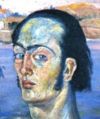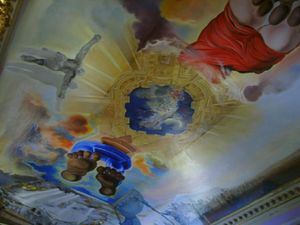Salvador Dali
 From Conservapedia
From Conservapedia 

| Salvador Dali | |
1st Marquess of Dalí of Púbol
| |
| In office 1982 – January 23, 1989 | |
| Born | Salvador Domingo Felipe Jacinto Dalí i Domènech May 11, 1904 Figueres, Catalonia, Spain |
|---|---|
| Died | January 23, 1989 (aged 84) Figueres, Catalonia, Spain |
Salvador Dali (1904-1989, both born and died in Figueres, Spain) was a Spanish Surrealist painter and sculptor, whose work includes one of the 15 most famous paintings of all time: The Persistence of Memory (1931), as displayed at the Museum of Modern Art. Surrealism was a more conservative alternative to Cubism, which was a competing trend in art throughout the 1900s. Dali's surrealism incorporated concepts of science and even infinity, unlike Cubism's rebellion against logic. Dali's work is featured in Hollywood movies (the 2022 movie Daliland is a biopic about him[1]), avant-garde television ads, and illustrations of the Bible.
Pro-life, Dali did spectacular spiritual paintings, including many illustrations of Dante's Divine Comedy as commissioned by Italy, and the Immaculate Conception as commissioned by the Vatican (the Madonna of Port Lligat, 1949[2]). Dali had phenomenal technical skills at painting, superior to his contemporaries. In Paris in 1929, Dali met Joan Miró, Andre Breton and his Surrealist group, the Romanian Dadaist Tristan Tzara and Paul Eluard. It was here that Dali first met Gala, his future wife of nearly 50 years. Politically, Dali supported the successful elimination of communism from Spain by Franco. Spiritually, Dali converted from atheism to Christianity after painting his "Vision of Hell."[3] Dali's father was a hardened atheist, while his mother was a devout Catholic.
"Cutting-edge scientific theory ... was always a huge influence on Dali. Later in life he became fascinated by quantum physics and the Uncertainty Principle ...."[4] Dali's early works were experiments with contemporary techniques, including Impressionist works like Self-Portrait (1921) and Pointillist works like Nude in a Landscape (1922-1923). Portrait of the Cellist Ricardo Pichot (1920) and Portrait of Luis Buñuel (1924) lean closer towards Post-Impressionism, and Venus and Amorini (1925) is executed in the Cubist style. A Dali museum opened in 1982 in St. Petersburg, Florida, and is the center of fine arts for that city.[5]
In 1938, Dali traveled to London, meeting with Sigmund Freud and painting a number of portraits of the famous psychologist. In 1946, Dali drew cartoons for Walt Disney, and did work for the Alfred Hitchcock film Spellbound. In 1978, Dali became a member of the Academie des Beaux-Arts in Paris.[6]

Dali's best-known works typically depict strange, dreamlike scenes or collections of objects in flat, otherwise featureless landscapes. Common subjects include vividly colored, often contorted human and animal forms, and optical tricks such as swans whose reflections appear like elephants.
Dali supported the Spanish dictator Francisco Franco (even painting a portrait of Franco's granddaughter) and declared himself monarchist in his 1970 book Dali by Dali. He also denounced surrealist filmmaker Luis Buñuel as an atheist. However, his political views were more of an artistic pose than the product of sincere convictions.
But he has often denied to be a fascist. In his autobiography is written:
| “ | "They called [...] from me that I should finally decide to become a Stalinist or Hitlerist. No! [...] I would always stay up to death the one who I was, and only Dalí Dalí! I did not believe in the communist revolution even in the National Socialist revolution. " Salvador Dalí | ” |
Dali is considered to have possessed excellent painting skills – his works were technically brilliant – and an extraordinary imagination. His most famous work is The Persistence Of Memory, and the melting clocks it depicts are the image most associated with his style.
Contents
- 1 Petite Gallery
- 2 Pro-Life
- 3 Quotations
- 4 See also
- 5 External links
- 6 References
Petite Gallery[edit]

"Self-Portrait"

"The First Day of Spring"

"Figure on the Rocks"

"The Persistence of Memory"

"Venus and Sailor"

"The Rotting Donkey"

"The Invisible Man"

"The Virgin of Guadalupe"
"The Christ of St. John of the Cross"
Pro-Life[edit]
Dali included the unborn child in some of his paintings, and he denied his official date of birth by saying instead he enjoyed his pre-birth time immensely as an unborn child. Dali called his time as an unborn child "paradise".
Quotations[edit]
| “ | One day it will have to be officially admitted that what we have christened reality is an even greater illusion than the world of dreams.
Have no fear of perfection - you'll never reach it.
|
” |
See also[edit]

- Painting Masterpieces
- Painting Schools
- Gallery Francisco de Goya
External links[edit]
- Salvador Dalí Foundation
- Salvador Dali Museum
- Salvador Dali Sculpture
References[edit]
- ↑ https://deadline.com/2022/08/daliland-ezra-miller-tiff-closing-night-film-1235088092/
- ↑ https://epublications.marquette.edu/cgi/viewcontent.cgi?article=1731&context=phil_fac
- ↑ https://catholicismpure.wordpress.com/2021/05/17/fatima-vision-of-hell-helped-atheist-salvador-dali-return-to-god/
- ↑ https://www.newstatesman.com/culture/2012/11/five-things-you-didnt-know-about-salvador-dali-2
- ↑ https://thedali.org/about-the-museum/
- ↑ Biography Olga's Gallery
Categories: [Pro-Life] [Spanish Painters] [Sculptors]
↧ Download as ZWI file | Last modified: 03/03/2023 14:09:25 | 24 views
☰ Source: https://www.conservapedia.com/Salvador_Dali | License: CC BY-SA 3.0
 ZWI signed:
ZWI signed: KSF
KSF